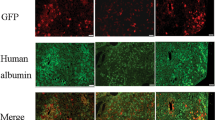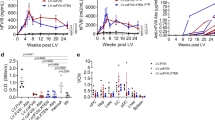Abstract
Coagulation factor X (FX)-binding ablated adenovirus type 5 (Ad5) vectors have been genetically engineered to ablate the interaction with FX, resulting in substantially reduced hepatocyte transduction following intravenous administration in rodents. Here, we quantify viral genomes and gene transfer mediated by Ad5 and FX-binding-ablated Ad5 vectors in non-human primates. Ad5 vectors accumulated in and mediated gene transfer predominantly to the liver, whereas FX-binding-ablated vectors primarily targeted the spleen but showed negligible liver gene transfer. In addition, we show that Ad5 binding to hepatocytes may be due to the presence of heparan sulfate proteoglycans (HSPGs) on the cell membrane. Therefore, the Ad5–FX–HSPG pathway mediating liver gene transfer in rodents is also the mechanism underlying Ad5 hepatocyte transduction in Microcebus murinus.
This is a preview of subscription content, access via your institution
Access options
Subscribe to this journal
Receive 12 print issues and online access
$259.00 per year
only $21.58 per issue
Buy this article
- Purchase on Springer Link
- Instant access to full article PDF
Prices may be subject to local taxes which are calculated during checkout




Similar content being viewed by others
References
Jaffe HA, Danel C, Longenecker G, Metzger M, Setoguchi Y, Rosenfeld MA et al. Adenovirus-mediated in vivo gene transfer and expression in normal rat liver. Nat Genet 1992; 1: 372–378.
Tao N, Gao GP, Parr M, Johnston J, Baradet T, Wilson JM et al. Sequestration of adenoviral vector by Kupffer cells leads to a nonlinear dose response of transduction in liver. Mol Ther 2001; 3: 28–35.
Schnell MA, Zhang Y, Tazelaar J, Gao GP, Yu QC, Qian R et al. Activation of innate immunity in nonhuman primates following intraportal administration of adenoviral vectors. Mol Ther 2001; 3: 708–722.
Koizumi N, Kawabata K, Sakurai F, Watanabe Y, Hayakawa T, Mizuguchi H . Modified adenoviral vectors ablated for coxsackievirus-adenovirus receptor, alphav integrin, and heparan sulfate binding reduce in vivo tissue transduction and toxicity. Hum Gene Ther 2006; 17: 264–279.
Mizuguchi H, Koizumi N, Hosono T, Ishii-Watabe A, Uchida E, Utoguchi N et al. Car—or alphav integrin-binding ablated adenovirus vectors, but not fiber-modified vectors containing RGD peptide, do not change the systemic gene transfer properties in mice. Gene Therapy 2002; 9: 769–776.
Nicklin S, Wu E, Nemerow G, Baker A . The influence of adenovirus fiber structure and function on vector development for gene therapy. Mol Ther 2005; 12: 384–393.
Alba R, Bradshaw AC, Parker AL, Bhella D, Waddington SN, Nicklin SA et al. Identification of coagulation factor (F)X binding sites on the adenovirus serotype 5 hexon: effect of mutagenesis on FX interactions and gene transfer. Blood 2009; 114: 965–971.
Parker AL, Waddington SN, Nicol CG, Shayakhmetov DM, Buckley SM, Denby L et al. Multiple vitamin K-dependent coagulation zymogens promote adenovirus-mediated gene delivery to hepatocytes. Blood 2006; 108: 2554–2561.
Shayakhmetov DM, Gaggar A, Ni S, Li ZY, Lieber A . Adenovirus binding to blood factors results in liver cell infection and hepatotoxicity. J Virol 2005; 79: 7478–7491.
Vigant F, Descamps D, Jullienne B, Esselin S, Connault E, Opolon P et al. Substitution of hexon hypervariable region 5 of adenovirus serotype 5 abrogates blood factor binding and limits gene transfer to liver. Mol Ther 2008; 16: 1474–1480.
Waddington SN, McVey JH, Bhella D, Parker AL, Barker K, Atoda H et al. Adenovirus serotype 5 hexon mediates liver gene transfer. Cell 2008; 132: 397–409.
Kalyuzhniy O, Di Paolo NC, Silvestry M, Hofherr SE, Barry MA, Stewart PL et al. Adenovirus serotype 5 hexon is critical for virus infection of hepatocytes in vivo. Proc Natl Acad Sci USA 2008; 105: 5483–5488.
Alba R, Bradshaw AC, Coughlan L, Denby L, McDonald RA, Waddington SN et al. Biodistribution and retargeting of FX-binding ablated adenovirus serotype 5 vectors. Blood 2010; 116: 2656–2664.
Bradshaw AC, Parker AL, Duffy MR, Coughlan L, van Rooijen N, Kähäri VM et al. Requirements for receptor engagement during infection by adenovirus complexed with blood coagulation factor X. PLoS Pathog 2010; 6: e1001142.
Lievens J, Snoeys J, Vekemans K, Van Linthout S, de Zanger R, Collen D et al. The size of sinusoidal fenestrae is a critical determinant of hepatocyte transduction after adenoviral gene transfer. Gene Therapy 2004; 11: 1523–1531.
Hamid O, Varterasian ML, Wadler S, Hecht JR, Benson III A, Galanis E et al. Phase II trial of intravenous CI-1042 in patients with metastatic colorectal cancer. J Clin Oncol 2003; 21: 1498–1504.
Morral N, O’Neal WK, Rice K, Leland MM, Piedra PA, Aguilar-Córdova E et al. Lethal toxicity, severe endothelial injury, and a threshold effect with high doses of an adenoviral vector in baboons. Hum Gene Ther 2002; 13: 143–154.
Ni S, Bernt K, Gaggar A, Li ZY, Kiem HP, Lieber A . Evaluation of biodistribution and safety of adenovirus vectors containing group B fibers after intravenous injection into baboons. Hum Gene Ther 2005; 16: 664–677.
Smith TA, Idamakanti N, Marshall-Neff J, Rollence ML, Wright P, Kaloss M et al. Receptor interactions involved in adenoviral-mediated gene delivery after systemic administration in non-human primates. Hum Gene Ther 2003; 14: 1595–1604.
Raper SE, Haskal ZJ, Ye X, Pugh C, Furth EE, Gao GP et al. Selective gene transfer into the liver of non-human primates with E1-deleted, E2A-defective, or E1-E4 deleted recombinant adenoviruses. Hum Gene Ther 1998; 9: 671–679.
Brunetti-Pierri N, Stapleton GE, Palmer DJ, Zuo Y, Mane VP, Finegold MJ et al. Pseudo-hydrodynamic delivery of helper-dependent adenoviral vectors into non-human primates for liver-directed gene therapy. Mol Ther 2007; 15: 732–740.
Fontanellas A, Hervás-Stubbs S, Mauleón I, Dubrot J, Mancheño U, Collantes M et al. Intensive pharmacological immunosuppression allows for repetitive liver gene transfer with recombinant adenovirus in nonhuman primates. Mol Ther 2010; 18: 754–765.
Sullivan DE, Dash S, Du H, Hiramatsu N, Aydin F, Kolls J et al. Liver-directed gene transfer in non-human primates. Hum Gene Ther 1997; 8: 1195–1206.
Sakurai F, Nakamura S, Akitomo K, Shibata H, Terao K, Kawabata K et al. Transduction properties of adenovirus serotype 35 vectors after intravenous administration into nonhuman primates. Mol Ther 2008; 16: 726–733.
Nunes FA, Furth EE, Wilson JM, Raper SE . Gene transfer into the liver of nonhuman primates with E1-deleted recombinant adenoviral vectors: safety of readministration. Hum Gene Ther 1999; 10: 2515–2526.
Schuettrumpf J, Zou J, Zhang Y, Schlachterman A, Liu YL, Edmonson S et al. The inhibitory effects of anticoagulation on in vivo gene transfer by adeno-associated viral or adenoviral vectors. Mol Ther 2006; 13: 88–97.
Wisse E, Jacobs F, Topal B, Frederik P, De Geest B . The size of endothelial fenestrae in human liver sinusoids: implications for hepatocyte-directed gene transfer. Gene Therapy 2008; 15: 1193–1199.
Nicol CG, Graham D, Miller WH, White SJ, Smith TA, Nicklin SA et al. Effect of adenovirus serotype 5 fiber and penton modifications on in vivo tropism in rats. Mol Ther 2004; 10: 343–353.
Seiradake E, Henaff D, Wodrich H, Billet O, Perreau M, Hippert C et al. The cell adhesion molecule ‘CAR’ and sialic acid on human erythrocytes influence adenovirus in vivo biodistribution. PLoS Pathog 2009; 5: e1000277.
Acknowledgements
We thank Nicola Britton and Gregor Aitchison at the British Heart Foundation Glasgow Cardiovascular Research Centre (BHF GCRC) for technical assistance. This work was supported by the European Commission FP7 BRAINCAV program.
Author information
Authors and Affiliations
Corresponding author
Ethics declarations
Competing interests
The authors declare no conflict of interest.
Rights and permissions
About this article
Cite this article
Alba, R., Bradshaw, A., Mestre-Francés, N. et al. Coagulation factor X mediates adenovirus type 5 liver gene transfer in non-human primates (Microcebus murinus). Gene Ther 19, 109–113 (2012). https://doi.org/10.1038/gt.2011.87
Received:
Revised:
Accepted:
Published:
Issue Date:
DOI: https://doi.org/10.1038/gt.2011.87
Keywords
This article is cited by
-
Challenges and progress toward tumor-targeted therapy by systemic delivery of polymer-complexed oncolytic adenoviruses
Cancer Gene Therapy (2022)
-
The Inflammatory and Fibrotic Patterns of Hepatic Stellate Cells Following Coagulation Factors (VII or X)-Shielded Adenovirus Infection
Current Microbiology (2021)
-
Differential immunogenicity between HAdV-5 and chimpanzee adenovirus vector ChAdOx1 is independent of fiber and penton RGD loop sequences in mice
Scientific Reports (2015)
-
FX and Host Defense Evasion Tactics by Adenovirus
Molecular Therapy (2013)
-
Interferon-α enhances antitumor activities of oncolytic adenovirus-mediated IL-24 expression in hepatocellular carcinoma
Molecular Cancer (2012)



